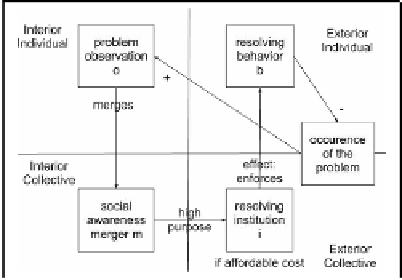Information Technology Reference
In-Depth Information
Fig. 1.
Conceptual diagram of the organization creation process using the MASQ
formalism [9]. Interior Individual represents the information process done within the
agent, Interior Collective represents the shared beliefs amongst the society, Exterior
Individual is what can be observed in the environment and Exterior Collective is what
is globally observable from the simulation at the collective level.
3 Related Work
Evolving Societies: Social Sciences Perspective.
Several authors [2,3,7,8]
formulated theories on the long-term evolution of human societies. According to
them, societies evolve through generic
stages
, each stage being characterized by
the creation of a new population-control organization that tackles issues caused
by shifts in population size. Thus, this theoretical framework fits the type of
models we want to build with our method. Our model is mainly inspired by
Diamond's theory because it proposes well-described transitions (problem and
solutions) at the individual level. Nonetheless, depicted stages (band, tribe, chief-
dom and state) are relatively similar across theories. As bands and tribes have
similar organizational entities, with the difference that bands are smaller and
nomadic our model starts with the tribe stage.
Each social stage corresponds to a social paradigm, which fits a given popula-
tion size. For instance, a society with 100 members and another one with 10000
members cannot work the same way, for obvious practical reasons (e.g. resource
management, decision making). Theories describe that the social stage changes
when the population reaches the population-control limits of its society in cre-
ating a new population-control organization. Otherwise, if the population is too
big for the social stage, social issues prevent the population to grow further. If
the population is too small, some population-control organization become useless
and are removed.
Tribes are groups from 80 to a few hundred people. The population is small
enough to keep short the inter-individual familial distance. This kinship is a nat-
ural population-control mechanism favoring mutual exchanges and preventing
fights to occur even in dicult conditions. There is no formal power centralizing
information and decision which is reached through consensus.




